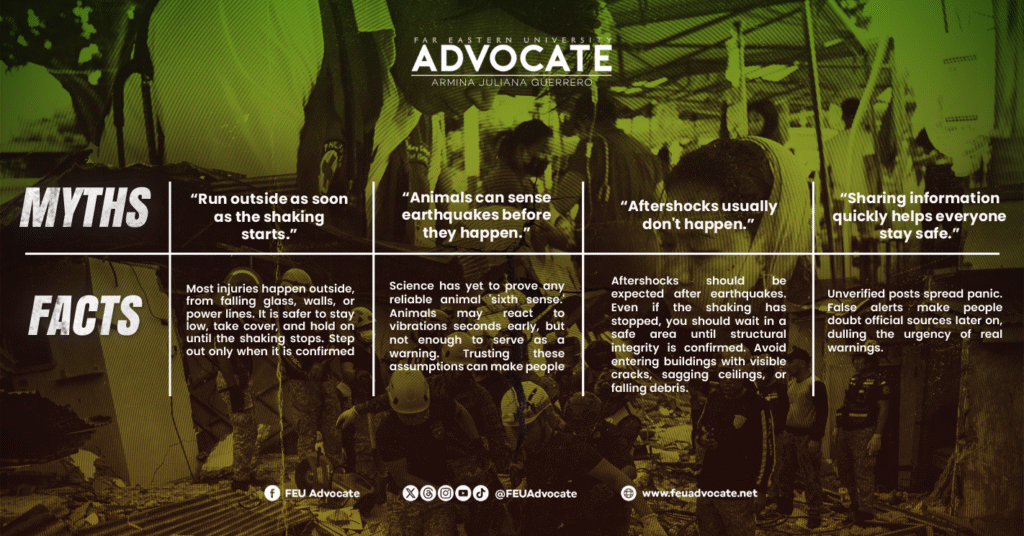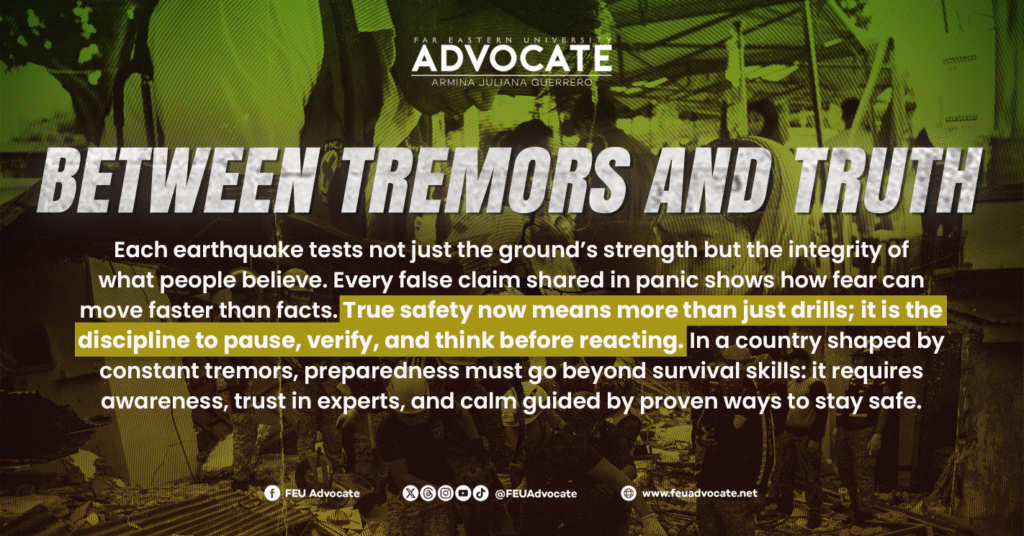
FEU yields highest rank, rating since 2000
- November 29, 2024 15:29
FEU Advocate
November 10, 2025 20:03

By Julienne G. Tan
When a 5.0-magnitude earthquake from Zambales rippled through Metro Manila on October 11, the city fell into a quivering silence. At Far Eastern University (FEU), students rushed outside as phones lit up with alerts and anxious messages. Within minutes, social media was filled with rumors, false warnings, and conflicting safety tips. What began as a brief tremor quickly spiraled into a frenzy of confusion and fear—on the ground and online.
The quake struck in the midst of a string of stronger tremors. On September 30, a magnitude 6.9 quake hit Northern Cebu, shaking homes and nerves across Visayas. Less than two weeks later, a 7.4 earthquake rocked Davao Oriental on October 10, serving as a reminder of the country’s deep seismic vulnerability. But just as seismic waves ripple through the ground, misinformation closely followed afterward.
Even in a country long accustomed to earthquakes, confusion that stems from panic and uncertainty remains a danger. False notions of safety persist, showing how fear and habit are harder to unlearn than learn.
In moments of panic, people fall back on what feels familiar. Habits, even the dangerous ones, become comfortable when the world begins to shake. Of all these reflexes, the strongest is the urge to run—toward safety, and often, into greater danger.

When fear outruns reason
When the ground trembles, the body reacts before the brain does. The instinct to flee and find open air feels rational, but in cities surrounded by concrete buildings, glass, and power lines, that reflex can be deadly.
The first instinct is always to run—to get out, to breathe, to be anywhere but inside. But, Philippine Institute of Volcanology and Seismology (PHIVOLCS) warns that the danger zoften waits beyond the door: shattering glass, falling wires, and collapsing walls can endanger those fleeing outside.
When the ground trembles, instinct takes command. The body floods with adrenaline, urging flight over thought, and in that split second, each hurried step becomes its own hazard in a moment when staying still could save lives.
Safety, PHIVOLCS reminds, starts with resisting the body's own panic—drop, cover, and hold—even when every instinct tells you to run. When there is no shelter in sight, crouching low and guarding your head becomes the next best defense before carefully finding an open space once it is safe.
True earthquake safety goes beyond impulse—it means unlearning the habits that put lives at risk. Yet once the tremors stop, another kind of danger emerges: misinformation. In the search for control, people cling to any post or claim that echoes safety.

The comfort of false certainty
When the earth moves, Filipinos search for meaning: through group chats, Facebook posts, and neighborhood stories of barking dogs and other myths. In the lull before official news, baseless assumptions take the place of answers.
In the search for order after every quake, a new kind of confusion emerges, one fueled by artificial intelligence (AI). Online, AI-generated videos and fake CCTV clips can be spread within minutes, followed by fabricated news reports that heighten fear. These videos and posts only deepen the confusion, blurring the line between fact and misinformation, especially for those less familiar with digital manipulation.
After almost every tremor, familiar stories resurface of animals said to sense danger before humans, and of supposed predictions that spread online just hours before the quake. These stories spread fast, not because people are naive, but because the uncertainty is unbearable. In the chaos that follows a disaster, even fabricated ones can offer false comfort amid confusion.
The United States Geological Survey (USGS) reports no reliable proof that animals can predict earthquakes. Some may sense the first faint seismic waves known as P-waves seconds before humans do, but the interval is far too short to offer any real warning. Most stories about animals ‘predicting’ quakes are based on fear, coincidence, or hindsight.
The same craving for control fuels belief in online predictions. Despite their popularity, no website or app can accurately predict when, where, or how strong an earthquake will be. These tools only detect shaking once it has already begun.
Yet many still treat them like oracles—the fortune tellers and viral ‘psychic predictions’ that flood social media after every tremor. Whether framed as science or superstition, these forecasts only offer comfort than certainty.
Many trust what they see online because the collective panic feels comforting. The need to belong outweighs the instinct to verify information, allowing emotion to move faster than truth, and misinformation to swiftly follow.
Online, panic does not stay private; it spreads, turning individual fear into an echo. Social media incentivizes instant reaction over verified response, making private fear into public misinformation.
Combating that digital aftershock requires more than calm—it demands collective discipline: fast, credible voices that cut through the noise before panic becomes another aftershock.
Earthquakes can strike twice
For many students, the moments after the quake were filled with tension and waiting. When the ground finally stilled, a false sense of safety can make people go back inside. But in that pause lies a danger often overlooked: aftershocks.
In an interview with FEU Advocate, Ella Ibal, a first-year Nursing student, recalled that even after the shaking from the October 11 earthquake subsided on campus, fear lingered as students turned to their phones and friends for reassurance.
She recalled that minutes after she and the rest of the students at The Huddle moved to the designated evacuation area, campus responders and security personnel quickly assisted students out of the buildings and directed them to safety, keeping the situation under control.
“The atmosphere after the quake was tense but controlled. Within minutes, responders were guiding everyone to safety, but even then, people were still checking their phones, asking if more shaking was coming,” she said.
The USGS reports that smaller quakes, also known as aftershocks, can strike in the period following a mainshock or larger earthquake, which can further damage already weakened structures.
Buildings that survived the initial tremor may now harbor hidden fractures, loosened beams, compromised walls, or weakened foundations. An aftershock may not need to be as powerful as the main quake to topple them.
When the tremors subside, resist the urge to go back indoors right away. Stay in clear spaces and watch for signs of damage such as cracks on walls, sagging ceilings, or debris that could mean the structure has been weakened.
Remember: survival after an earthquake often depends not only on what happens during the quake, but on the restraint and caution that follow.

Despite years of earthquake drills and public advisories, false safety tips still circulate faster than official updates. The persistence of these beliefs showcase something deeper than ignorance: it reveals issues of mistrust and fear.
Many Filipinos do not always receive or trust accurate information. When government advisories and action after disasters are delayed, it leaves people desperate and seeking answers. This results in self-proclaimed ‘experts’ and viral posts thriving, offering comfort in misguided answers.
This pattern does not just happen online, but it plays out in real time, even in schools and communities. Ibal witnessed this firsthand during the earthquake at FEU, where she noticed how fear and misinformation spread hand in hand, making it harder to distinguish genuine urgency from false alarms.
“No matter how strong the earthquake was, it was the fear and panic that spread even faster than the shaking itself. I realized that being prepared isn’t just about knowing what to do, but also about controlling how you react in the moment,” she reflected.
Preparedness depends on collective effort—one that connects classrooms, workplaces, and communities. It begins when earthquake drills are taken seriously, when employees know how to respond calmly, and when local leaders ensure that verified information reaches everyone. Together, these actions build lasting resilience.
In the aftermath of every tremor, fear is always the first to ripple through the crowd. But knowledge that is deliberate and verified must follow close behind.
The earth beneath us will always move, and preparedness is our only solution. Every verified fact shared and every rumor stopped does more to protect lives than panic and misinformation ever could. In the noise that follows disaster, let reason be louder than fear.
(Layout by Armina Juliana Guerrero/FEU Advocate)









